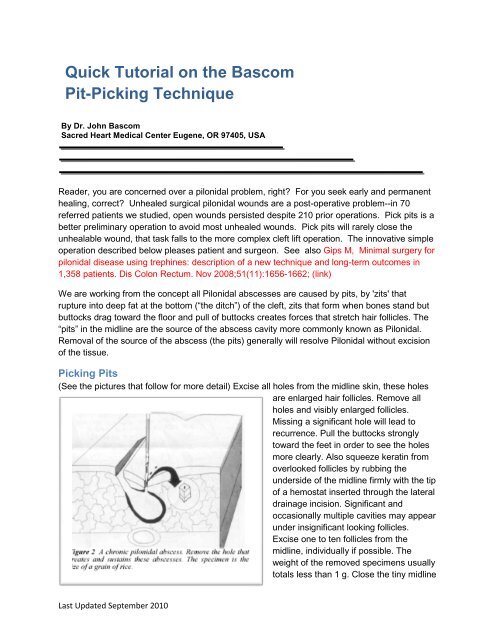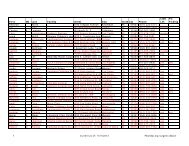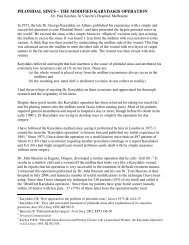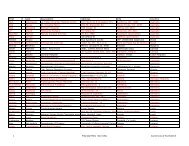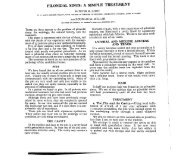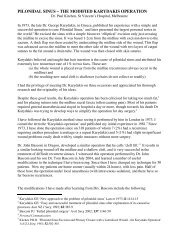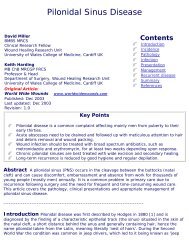Quick Tutorial on the Bascom Pit-Picking ... - Pilonidal Disease
Quick Tutorial on the Bascom Pit-Picking ... - Pilonidal Disease
Quick Tutorial on the Bascom Pit-Picking ... - Pilonidal Disease
- No tags were found...
You also want an ePaper? Increase the reach of your titles
YUMPU automatically turns print PDFs into web optimized ePapers that Google loves.
openings using a removable subcuticular 4-0 Prolene suture.When presented with an acute abscess, our technique is to drain <strong>the</strong> abscess laterally, afinger’s width off <strong>the</strong> midline (STAY OUT OF THE DITCH!) Once <strong>the</strong> abscess is open, drainedand scrubbed out, we send <strong>the</strong> patient home for 10 days for edema to fade – we do not pack<strong>the</strong> abscess. When <strong>the</strong> patient with <strong>the</strong> drained abscess returns to <strong>the</strong> office, <strong>the</strong> edema willhave cleared and <strong>the</strong> pits will be easily visible by pulling <strong>the</strong> midline skin towards <strong>the</strong> feet. We<strong>the</strong>n excise all pits from <strong>the</strong> midline.Pictorial GuidePictures 1 - 5 are <strong>the</strong> same pers<strong>on</strong>, a youth with a slightly tender nodule over <strong>the</strong> sacrum. Note<strong>the</strong> minimal body hair. But note that in 1) <strong>the</strong> hands pull <strong>the</strong> skin toward <strong>the</strong> feet. This makes <strong>the</strong>pits show clearly. They were nearly invisible in 5). The pits are easily missed without <strong>the</strong> pull.This dem<strong>on</strong>strati<strong>on</strong> of <strong>the</strong> way a pull <strong>on</strong> skin enlarges pits gives a hint of <strong>the</strong> way <strong>the</strong> same pullcreates <strong>the</strong> pits and enlarges <strong>the</strong>m. The weight of <strong>the</strong> buttocks pulls skin away from sacrum in astanding patient. All that keeps <strong>the</strong> buttocks from falling into our socks is a narrow line ofattachment to <strong>the</strong> tip of <strong>the</strong> tailb<strong>on</strong>e. If <strong>the</strong> pull grows str<strong>on</strong>g enough, something will give way.The weakest point which gives way is skin where it is thinnest, at <strong>the</strong> bottom of a hair follicle. Orskin where a hair drills in to thin it, where skin is thinnest at <strong>the</strong> bottom of <strong>the</strong> drill hole.The c<strong>on</strong>tinued pull tends to enlarge <strong>the</strong> pits and pull in hairs that may lie in <strong>the</strong> cleft, thanks tobarbed <strong>the</strong> scales <strong>on</strong> hairs which act like barbs <strong>on</strong> a fishhook. Hairs, as seen from a skin cell <strong>on</strong><strong>the</strong> side of <strong>the</strong> cleft, loose hairs brush by. But as seem from a skin cell in <strong>the</strong> bottom of <strong>the</strong> cleft,loose hairs come like a railroad train; end <strong>on</strong> and driving.Look at pits in a standing patient. C<strong>on</strong>trast that view with <strong>the</strong> view of pits <strong>on</strong> a patient supine <strong>on</strong>an exam table.An abscess starts in fat <strong>on</strong>ce skin germs invade fat, sneaking in through <strong>the</strong> pinhole at <strong>the</strong>bottom of a pit.Close <strong>the</strong> pit to stop <strong>the</strong> disease. Usually we have to empty <strong>the</strong> abscess also.Picture 6One week after pick pits and stay out of <strong>the</strong> ditch. The small stitches are ready for removal frompits removal. The n<strong>on</strong>-tender healing wound will be closed in 2 weeks. Keep <strong>the</strong> site clean withBabyWipes four times a day followed by Betadine-wet gauze for a minute in additi<strong>on</strong> to twice aday showers.Last Updated September 2010
Picture 1 –This patient found a nodule under midline skin.We suspected it was a chr<strong>on</strong>ic pil<strong>on</strong>idal abscess.Our first look showed no pits. <strong>Pit</strong>s are <strong>the</strong>pinholes that start all pil<strong>on</strong>idal trouble. To find apit is a sure sign that <strong>the</strong> nodule is a pil<strong>on</strong>idalabscess.Picture 2 -Same patient, different light. We pulled skindown towards <strong>the</strong> feet to reveal four pits.Picture 3 –Path of infecti<strong>on</strong> from pits to chr<strong>on</strong>ic abscessLast Updated September 2010
Picture 4 –Treatment opti<strong>on</strong> #1Pick all pits (Excise each enlarged hair follicle).Stay out of <strong>the</strong> ditch (Place drainage incisi<strong>on</strong>over <strong>the</strong> abscess but lateral to midline).Scrub out all cavities.Most of early patients can be treated asoutpatients under local anes<strong>the</strong>tic. Sideincisi<strong>on</strong>s heal 100%.Picture 5 –Treatment Opti<strong>on</strong> #2.Simplest Opti<strong>on</strong>Cut <strong>on</strong> red line through all pits and across <strong>the</strong>abscess cavity.Scrub <strong>the</strong> lining clean.Keep <strong>the</strong> cleft clean and allow incisi<strong>on</strong> to heal.This cures ≈ 80% of cases and never producelarge unhealed wounds.If a small part of wound fails to close in 3-6weeks, <strong>the</strong>n a cleft lift is a good opti<strong>on</strong>.Avoid midline sutures or packing and wide EXCISION!Some MDs favor sewing skin edges to bottom of abscess, “marsupializati<strong>on</strong>”, but NOT to presacral fascia.Some fill with fibrin glue.Last Updated September 2010
Picture 6 –Post-op 2 days in different patients.We had picked a single pit out of <strong>the</strong> midline andclosed it with a single stitch of m<strong>on</strong>ofilament, <strong>the</strong>stitch to be removed at <strong>on</strong>e week. In this photo<strong>on</strong> <strong>the</strong> sec<strong>on</strong>d postoperative day, <strong>the</strong> stitch isbarely visible. The apparent pit in <strong>the</strong> midline isa gap in <strong>the</strong> wound that we expect will heal.We had opened <strong>the</strong> abscess cavity with a lateral incisi<strong>on</strong>. The extra skin removed from <strong>the</strong> left edge permittedfree drainage if necessary. It was used to prevent premature closure of <strong>the</strong> rapidly healing incisi<strong>on</strong>. Weremoved most of <strong>the</strong> hair and scrubbed granulati<strong>on</strong> tissue through this wound.On <strong>the</strong> day after office surgery under local anes<strong>the</strong>tic, <strong>the</strong> patient drove 200 miles without needing pain pills.Last Updated September 2010


